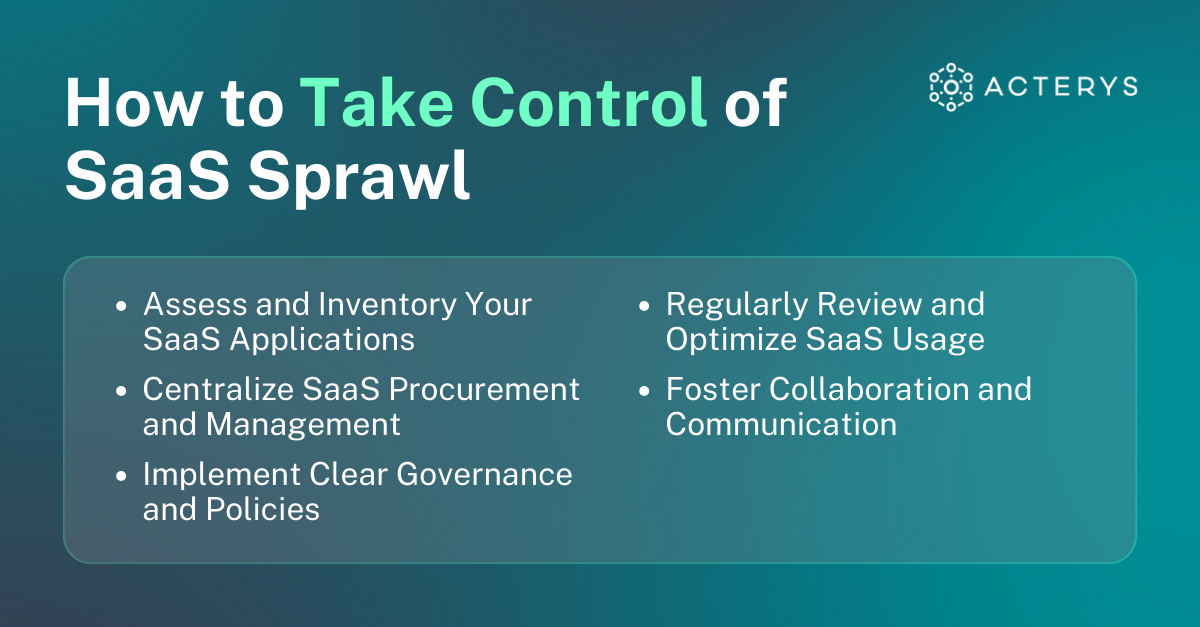
Table of Contents
As organizations increasingly rely on cloud-based software solutions, the ease of subscribing to and implementing SaaS applications has led to a rapid growth in their adoption. However, this widespread adoption often leads to SaaS sprawl. As a result, CIOs and CTOs are faced with increased costs, security risks, and integration complexities.
According to Gartner, 61% of software buyers plan to increase their technology investments in 2024. As businesses look to invest in new technologies and optimize their services and applications, technology leaders need visibility and control over the overall SaaS landscape. They need a way to assess and inventory their existing SaaS applications, identify redundancies and underused tools, and make informed decisions about consolidating, eliminating, or optimizing their SaaS subscriptions.
What Is SaaS Sprawl?
Imagine a bustling organization with different teams and departments, each with their own unique needs and goals. To meet these specific requirements, these teams independently start adopting various Software-as-a-Service (SaaS) applications. One team might choose a project management tool, while another opts for a customer relationship management (CRM) system. Yet another team might go for a collaboration platform. And so it goes on. This is what we call SaaS sprawl.
SaaS sprawl happens when there’s a lack of coordination or oversight from IT or management, resulting in a fragmented SaaS ecosystem. It’s like a garden where each plant grows independently, without any planned arrangement or guidance. Without a clear strategy or framework in place, teams are left to their own devices, making individual decisions about which SaaS applications to adopt.
Sometimes, teams resort to using SaaS applications without the knowledge or approval of the IT department. They find solutions individually to address their immediate needs, often bypassing established IT processes. This shadow IT behavior further adds to the fragmentation and lack of control over the SaaS landscape.
The Problem With SaaS Sprawl
This decentralized approach leads to a fragmented software landscape, resulting in increased financial, security, and operational risks. SaaS sprawl can lead to several challenges and issues, including:
- Increased costs: With multiple SaaS applications being used across different departments, organizations may end up paying for redundant or overlapping functionalities, leading to unnecessary expenses.
- Data security and compliance risks: Each SaaS application may have its own security protocols and compliance requirements. Without proper oversight, organizations may expose sensitive data or violate regulatory standards.
- Integration complexities: Integrating multiple SaaS applications can be challenging, especially when they are not designed to work together. This can hinder data flow and collaboration among different systems.
- User experience and productivity issues: Employees may face difficulties in navigating and switching between multiple applications, leading to a fragmented user experience and decreased productivity.
- Vendor management challenges: Managing relationships with multiple SaaS vendors, including contract negotiations, support, and updates, can become complex and time-consuming.

5 Benefits of Effective SaaS Management
Effective SaaS management plays a crucial role in reducing SaaS sprawl. By implementing a well-designed SaaS management strategy, you can unlock a range of benefits:
Cost Optimization
With the proliferation of SaaS applications across different departments, organizations often end up paying for redundant or overlapping functionalities. This leads to unnecessary expenses and a waste of financial resources. SaaS spend management lets businesses find and eliminate such redundancies in their tech stack and invest in the applications that provide the greatest value and ROI.
SaaS apps often come with additional costs beyond subscription fees, such as data storage, integrations, or premium support. Effective SaaS spend management can provide visibility into these hidden costs. This improved visibility also can help businesses determine what services are underused or no longer serving their intended purpose. Organizations can then use this information to negotiate rates or subscription plans with vendors and eliminate unused licenses.
Enhanced Security
SaaS applications often have their own security protocols and compliance requirements, which can lead to fragmented security measures if not properly managed. With effective SaaS management, businesses can establish centralized security protocols to make sure all SaaS apps adhere to the organization’s security standards. This includes defining guidelines for data access, user permissions, and integration requirements, reducing the risk of data breaches and ensuring compliance with industry regulations.
SaaS management also includes vendor management, which involves actively managing relationships with SaaS vendors, conducting due diligence on their security practices, and ensuring that they have robust security measures in place to protect customer data. Selecting reputable vendors and maintaining open lines of communication helps organizations stay informed about any security updates or vulnerabilities and take appropriate actions to safeguard their data.
Streamlined Operations
With a centralized approach to SaaS, organizations can assess and inventory their existing SaaS applications, identifying redundancies, underutilized tools, and data silos. This saves time and allows for better visibility and control over the overall SaaS landscape. Businesses can quickly make informed decisions about consolidating, eliminating, or optimizing SaaS subscriptions. Consolidating apps and services allows companies to streamline business operations and improve productivity and efficiency.
Effective SaaS management also fosters collaboration and communication between departments and teams, promoting a cohesive and efficient working environment. By establishing channels for sharing information and best practices regarding SaaS usage, organizations can identify opportunities for consolidation and ensure that the organization is leveraging the full potential of its SaaS investments.
Scalability and Flexibility
One key benefit of effective SaaS management is the ability to scale resources up or down as needed. With cloud-based SaaS applications, organizations can easily add or remove user licenses, storage capacity, or additional features to accommodate growth or changing demands. This scalability allows businesses to quickly respond to market changes, scale their operations, and avoid the need for significant upfront investments in hardware or software.
With a wide range of SaaS apps available, organizations can choose solutions that best fit their specific needs and requirements. This flexibility allows businesses to adopt new tools and technologies without the constraints of traditional on-premises software. Additionally, SaaS apps often offer customizable features and integrations, allowing organizations to tailor the software to their unique workflows and processes.
As services are adjusted, effective SaaS management enables organizations to easily integrate and connect different SaaS applications. This integration capability enhances flexibility by allowing data to flow seamlessly between systems, eliminating data silos and improving collaboration.
Future-Proofing
Implementing a well-designed SaaS management strategy empowers organizations to adapt to emerging technologies, embrace innovation, and set themselves up for long-term success. The process lets organizations seamlessly transition among different SaaS applications or providers. This flexibility ensures that businesses aren’t locked into a single vendor or solution, mitigating the risk of vendor lock-in. It also enables organizations to take advantage of new offerings or switch to more suitable solutions as their needs change over time.
Organizations that stay informed about the latest trends and advancements in the SaaS market can use this knowledge to evaluate new solutions that align with their evolving needs and industry standards. By embracing innovation and leveraging new technologies, organizations can gain a competitive edge and drive growth.
How to Take Control of SaaS Sprawl
Organizations need a comprehensive approach to SaaS management to address the challenges of SaaS sprawl and create a well-managed software ecosystem. This process involves updating internal practices and policies, optimizing usage, and creating an open, collaborative environment where employees can unlock greater value from existing tools and services.
Assess and Inventory Your SaaS Applications
The first step in taking control of SaaS sprawl is to gain a comprehensive understanding of the SaaS applications being used within your organization. Conduct a thorough assessment and inventory of all the SaaS tools in use, including those procured by different departments or individual employees. This will provide you with a clear picture of your entire SaaS portfolio and the extent of SaaS sprawl and help identify redundancies or underused applications.
Centralize SaaS Procurement and Management
Centralizing SaaS procurement and management is crucial to regaining control over your software ecosystem. Establish a centralized process for evaluating, approving, and procuring new SaaS applications. This will ensure that all SaaS tools align with the organization’s goals and requirements. Consider implementing a platform like Acterys that lets you consolidate your SaaS applications and unify analytics and planning, providing better visibility and control.
Implement Clear Governance and Policies
Establishing governance and policies around SaaS usage is essential to prevent the uncontrolled proliferation of SaaS applications. Define guidelines for SaaS procurement, usage, and data security. This includes setting standards for data access, user permissions, and integration requirements. By implementing clear policies, you can ensure that SaaS applications are used effectively and in line with the organization’s overall strategy.
Regularly Review and Optimize SaaS Usage
SaaS applications should be regularly reviewed to assess their value and usage. Identify apps that are underused or no longer serving their intended purpose and consider consolidating or eliminating them. Regularly review subscription plans and negotiate with vendors to optimize SaaS costs and ensure that you are only paying for the features and licenses you truly need.
Foster Collaboration and Communication
Encourage collaboration and communication among departments and teams to avoid duplication of SaaS tools. Establish channels for sharing information and best practices regarding SaaS usage. This will help identify opportunities for consolidation and ensure that the organization is leveraging the full potential of its SaaS investments.

Replace Point Solutions With a Comprehensive Platform
Organizations often find themselves resorting to multiple point solutions to address specific challenges. However, this approach can lead to SaaS sprawl, resulting in a fragmented software ecosystem that’s difficult to manage. Acterys offers a better alternative by providing a comprehensive platform that eliminates the need for numerous point solutions.
The reality is, even if your company only uses 30% of the features from a SaaS platform, you’re still responsible for 100% of the subscription costs. Not all organizations need an advanced toolset with added bells and whistles, which is why Acterys offers flexible and tailored solutions that allow businesses to pay for and use only the features they truly need. This enables organizations to optimize their SaaS subscriptions and maximize their return on investment.
Businesses can tap into a scalable and unified platform that offers expanded functionality and customization options. This platform approach allows organizations to start small and consolidate their SaaS stack over time. For example, Acterys Rapid Results Packs offer pre-built, tailored tools for specific use cases and industries, and our Augmented Business Solutions give businesses the ability to create streamlined access to custom-built applications for nearly any use case.
Using Acterys technology for a variety of use cases, businesses can consolidated data and gain comprehensive, real-time insights to make informed decisions and drive strategic initiatives For example, organizations can optimize supply chain management processes by building a tailored business app that tracks inventory levels, monitors demand patterns, and provides laser-focused insights for streamlining procurement operations. Similarly, Acterys Augmented Business Solutions can be used to manage and plan maintenance schedules of military vehicles, or building a complete end-to-end patient management and analytics system for a hospital. The possibilities are endless.
Acterys empowers organizations to replace their disparate point solutions one by one, gradually transitioning to a more unified approach. This cuts the frustrations associated with managing multiple systems, reduces implementation times, and provides greater control over software usage and costs.
Take control of your software ecosystem and embark on a journey toward a more unified and efficient future with Acterys. Get in touch with us to learn more about how Acterys can help your organization eliminate SaaS sprawl. Ready to optimize your SaaS management now? Get started with a 14-day trial.




